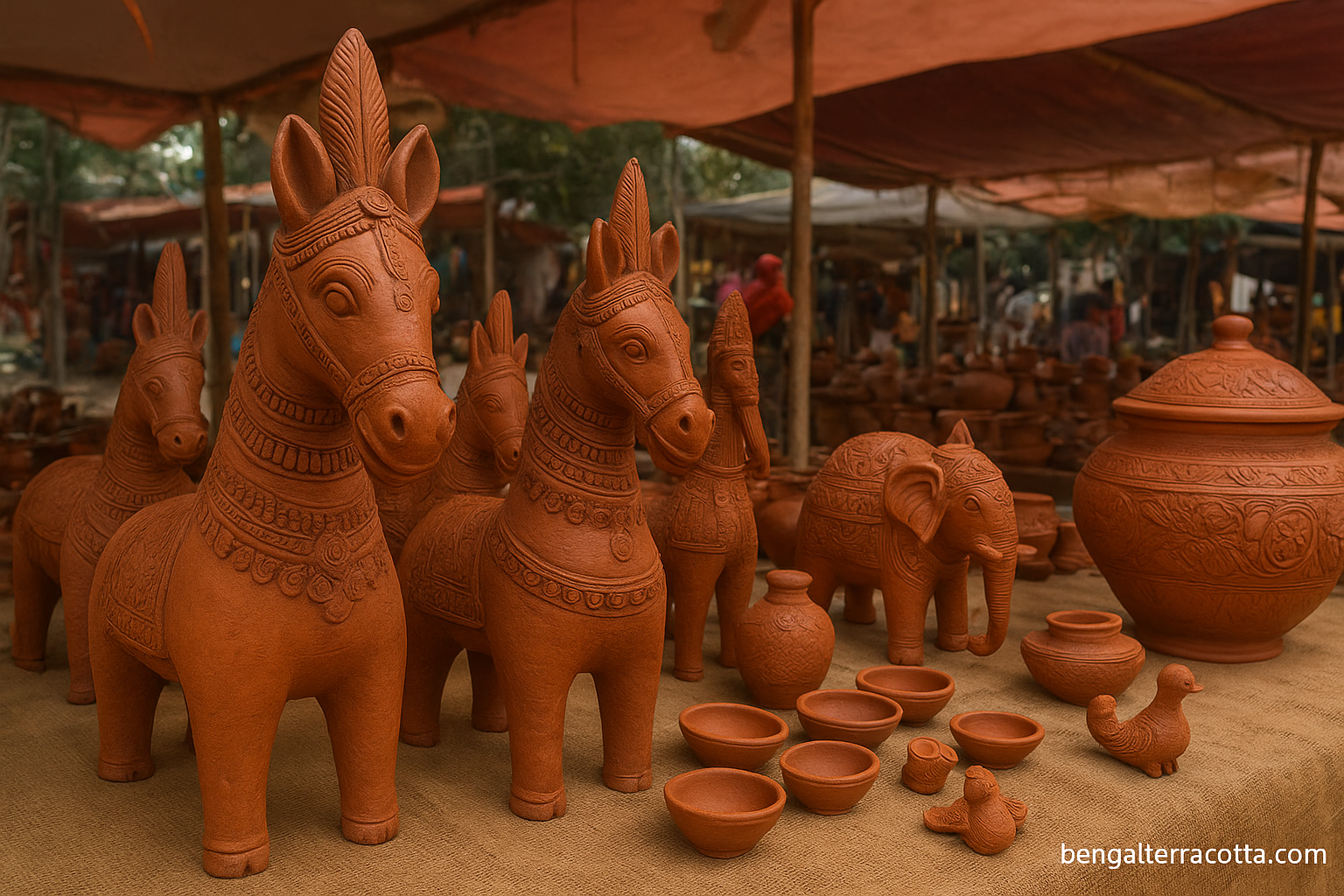Introduction: Earth, Heritage & Artistry
Bengal’s terracotta craft is not just a craft—it’s a living legacy. From sun-baked surfaces of temple walls to intricately modeled home décor, terracotta remains a vital link between centuries-old traditions and contemporary expressions. This blog takes you on a journey from raw clay to cultural icon.
1. Roots in Red Clay: The Terrain and Tradition
The vibrant red laterite soil of Bengal, particularly in regions like Bankura and Murshidabad, naturally adapted to terracotta artistry. Due to the absence of quality stone, artisans turned to clay—often shaped, fired, and molded into vessels, toys, architectural details, and ornamental artifacts.
2. The Glory of Terracotta Temples in Bishnupur
In the 17th and 18th centuries, under the patronage of the Malla kings, Bishnupur evolved into a terracotta wonderland. Temples like Jor Bangla, Rasmancha, and Madan Mohan showcase elaborate bas-reliefs narrating mythological epics—Mahabharata and Ramayana—etched into fired-clay panels.
Notably, Bishnupur’s terracotta culture extends beyond architecture to pottery, jewelry, and iconic motifs like horses, Ganesha, Nataraja, and elephants.
3. Panchmura and the Bankura Horse: Art in Form
In villages like Panchmura, terracotta artisans—known as Kumbhakar—craft the famed Bankura horses, notable for their elegant abstraction and symbolic significance. Originally used in rural rituals, they now grace global homes as folk-art icons and even serve as the logo for All India Handicrafts.
An estimated 450 artisans in Panchmura and nearby villages continue this legacy, often using communal kilns to fire creations ranging from household idols to decor pieces.
4. Themes and Motifs: Narrative in Clay
Bengal’s terracotta craft is rich in storytelling. Artisans mold scenes from mythology, daily life, rural landscapes, and flora and fauna onto their creations. These motifs extend from temple panels to modern decorative items—bridging past and present beautifully.
5. A Craft in Crisis: Contemporary Challenges
Despite its beauty, Bengal’s terracotta heritage faces real threats. With diminishing demand and ageing artisan communities, sustainability is at risk. For instance, villagers in some Bengal regions are struggling to sustain the craft amid financial strain and lack of market access.
This mirrors broader challenges faced by terracotta communities across India, such as those near Bhubaneswar, where high clay costs and market shifts have forced potters to shift from decorative art to purely utilitarian wares.
6. Revival, Reinvention & Relevance
Despite challenges, terracotta finds new life through adaptation. Artisans create contemporary home décor items, jewelry, wall art, and more—keeping traditional techniques alive while meeting modern tastes.
Moreover, cultural tourism in places like Bishnupur—especially during festivals and through museums—brings awareness and appreciation for terracotta arts. The Bishnupur Museum and heritage tours continue to showcase these crafts to a wider audience.
Conclusion: Preserving Clay, Honoring Culture
From temple facades to tabletop showpieces, Bengal’s terracotta craft is a testament to the enduring bond between material, place, and culture. Its survival hinges on awareness, demand, and support—be it from amateurs, collectors, cultural institutions, or e-commerce platforms like Bengal Terracotta that connect artisans to the world.
Let this journey inspire you to appreciate not just the visual beauty of terracotta, but the stories, skill, and heritage baked into every piece.
Bonus: How Bengal Terracotta Can Share This Story
To drive engagement and deepen connection, consider incorporating:
Timeline infographics tracing terracotta—from Panchmura artisans to Bishnupur temple builders.
Artisan interviews or profiles, bringing human faces and stories to your pieces.
Process snapshots—from clay preparation and molding to kiln firing and finishing.
Modern applications, like using terracotta jewelry or wall décor to complement contemporary interiors.

